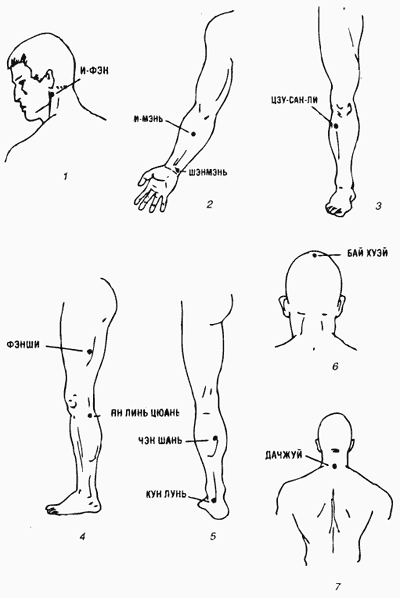Any person involved in martial arts, like anyone else, needs a massage. It allows you to warm up the muscles, ligaments and tendons before training, relieve tension after it, and also constantly maintain the body in readiness for work, stress and protect against injuries, overexertion and illness.
We will touch only on the most important and at the same time simplest types of self-massage, which is used by Wushu practitioners.
Self-massage should begin in the morning, shortly after waking up. This type of massage aims to prepare the body for the coming day and has a huge healing effect. In it, the objects of influence are both individual points and entire zones. In this case, massage techniques such as pressing, patting, rubbing, and rolling are used. The massage must be carried out with clean, dry and warm hands. All exercises should be performed in strict sequence.

1. Rolling while pressing the yi-feng point (Fig. 1), which is located in the depression behind the base of the earlobe, between the mastoid process and the ascending ramus of the mandible. Pressing with simultaneous rolling is done with the pads of the thumbs 18 times.
2. Tingling ears. It is done with the thumbs and forefingers while inhaling up the antitragus, and while exhaling along the tragus 7 times.
3. Rubbing the neck muscles. It is done from the front, side and back with both hands with slight pinching and downward pressure.
4. Smoothing hair. Run the fingers of the right hand through the hair from the forehead to the back of the head without pressing hard 8 times.
5. Rub your forehead with your palms from the center to your temples 7 times.
6. Rubbing the eyebrows and eyelids of closed eyes with your fingers from the bridge of the nose to the periphery 7 times.
7. Rubbing the cheeks from the nose to the lower jaw using the palms 7 times.
8. Massage the tip of the nose with the right palm by rubbing clockwise 8 times.
9. Massage the closed mouth with your palm clockwise 8 times.
10. Rubbing the chin (optional).
11. Pinching and lightly shaking the trapezius muscles with your fingers.
Next, proceed to massage the torso.
12. Place your right palm on the left side of your chest, cover it with your left palm on top and rub this side of your chest clockwise by rotating both palms 18 times.
13. The same on the right side of the chest.
14. The same thing, but counterclockwise in the liver area.
15. The same thing clockwise in the abdominal area.
This is followed by a hand massage.
16. Shaking, rubbing and lightly pinching the muscles of the shoulders and forearms.
17. Rolling the Xi-men point with your finger (Fig. 2), which is located 5 cun above the wrist fold (1 cun - 1.5-1.8 cm).
18. Rubbing palms, shaking and pinching fingers.
The last stage of this massage is the effect on the legs.
19. Shaking, rubbing and pinching the thigh muscles.
20. Rubbing, loosening and shaking the knee, pinching with fingers and pulling the tendons in the popliteal fold.
21. Tapping on the zusanli point with the pad of the index finger. The Zusanli point is located 3 cun below the knee, 1 cun from the front edge of the tibia on the outside of the shin. Perform 25 times (Fig. 3).
22. Tapping in the same way on the Yanglin-quan point, which is located on the outer side of the lower leg, in the depression below the head of the fibula (Fig. 4) 25 times.
23. Rubbing, shaking, tapping and pinching the calf muscles.
24. Pinching and pulling the Achilles tendon.
25. Rubbing, squeezing and shaking the foot, pinching the tendons of the toes, shaking and rubbing the toes.
26. Rubbing the sole with a fist.
In addition, you should perform the following exercises:
27. Rubbing the folds of the perineum with your palms.
28. Rubbing the lower back with fists until warmth appears.
In conditions of severe physical overload, it is extremely necessary to constantly perform a special massage, which is aimed at restoring muscles, ligaments and internal organs. The most important massage is the legs, as they receive the main load during training, as well as massage for mental recovery.



